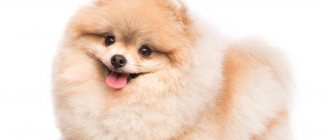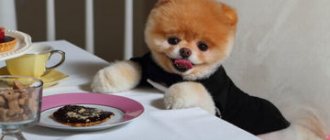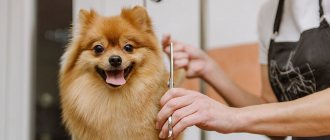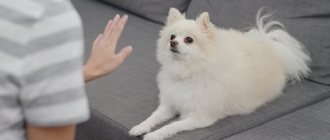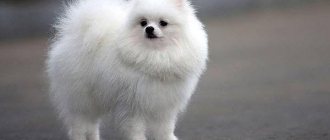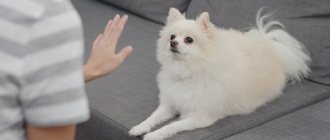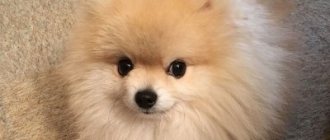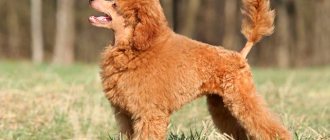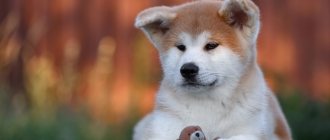Appearance
— Advertising —
The Pomeranian is a compact, short-haired, active small dog.
An adult animal weighs on average from 1.9 to 3.5 kg and grows to 18-22 cm. The ratio of body length to height at the withers is 1:1.
According to the standard, the animal has the following parameters:
— Advertising —
The head is wide at the back, tapering towards the nose. His facial expression is fox-like, which conveys his alertness and intelligent nature.
The eyes are dark or light, medium size, almond-shaped. Eye rims are black.
The ears are small and set high.
The skull is slightly rounded, but not convex. The muzzle is short and straight. The ratio of the length of the muzzle to the skull is 1/3 to 2/3. The nose is wet and mostly black. Scissor bite.
— Advertising —
The neck is well set and of such length that the head can look proud and tall. The chest is oval, tapering.
The back is short, straight and strong.
The tail is set high and lies flat and straight on the back.
Forelegs. The elbow joints are close to the body and positioned straight. The legs, when viewed from the front, are straight and parallel to each other. The height from the withers to the elbows is approximately equal to the height from the ground to the elbow.
Hind limbs. Thighs moderately muscular. The length of the upper thigh and lower leg are equal. The knees are strong, moderately arched and well defined. The legs, when viewed from behind, are straight and parallel to each other. The hock joints, when viewed from the side, are perpendicular to the ground. Otherwise, the hind legs are similar to the forelimbs.
The Pomeranian is a double-coated breed.
There are three different classifications of acceptable pet coat colors. They are divided as follows:
- Red, ginger, cream (beige), sable, sable wolf.
- Black, brown, blue.
- Any other acceptable color and colors. For example, red-sable, black-and-tan, particolor (color), zone-gray, yellow-brown, marbled (merle), blue, peach, milky, snow-white, fawn.
Pomeranian Spitz
This is a dwarf dog for decorative purposes. Description of the breed:
- Small head, with a clearly defined stop on the muzzle.
- The nose is small, black or dark brown.
- The ears are triangular, standing close together. From birth, puppies are hanging, rising as they grow.
- The eyes are small, dark, slanted, oval. The look is mischievous, the muzzle as a whole resembles a fox.
- The tail is of medium length, curved into a ring, lying on the back.
- The orange's coat is long, straight, and the undercoat is thick and dense. The color varies.
Pros and cons of a dog
Before making such a friend, study the pros and cons.
Characteristics of advantages:
- The animals are small, so they comply with size restrictions for airplanes and hotels.
- This is an active species. But at the same time, pets can meet most of their needs while indoors.
- Pomeranians are lightweight, making them great pocket dogs.
- Animals don't tend to break things in your home.
- Individuals will not pull you in different directions during a walk, as they do not have enough strength for this.
- The advantage of the breed is that the dog is not allergic.
- They are cheaper to feed, maintain and treat than larger species.
Characteristics of minuses:
- Dogs are fragile. If they jump from a long distance or are stepped on, pets can be seriously injured.
- Purebred Pomeranians are expensive due to their popularity.
- Individuals may be injured by other animals, including some birds.
- Pets shed heavily and therefore require daily care.
- Pomeranians bark a lot, as do many other small breeds.
- The downside is that the dogs are not suitable for families with small children.
- The individuals have one bad habit: they can mark different nooks and crannies of your house. The discharge can smell throughout the entire house, which can be a problem for you.
- Pomeranian owners sometimes tend to succumb to the “small dog syndrome.” This happens when the owners spoil the little dog so much that he believes that he is the head of the family. Remember that individuals can manipulate you.
Which type to choose
Whatever type of Pomeranian you focus your attention on, you need to clearly understand that the types of dogs do not in any way affect their character traits. Especially on the mental and physical condition of the pet.
If you are looking for a family friend and a good travel companion, then absolutely any type of Pomeranian will suit you. But if your goal is to participate in exhibitions or breed, then the best option would be dogs that best fit the basics of the standard.
You should not chase fashion, otherwise you risk purchasing a Pomeranian with serious problems:
- deviation from the standard due to inept removal, for example, snub nose, as a result of which malocclusion develops;
- hereditary diseases.
This is much more important than an unfashionable look or low price.
Which type do you prefer and why?
History of the origin of the breed
Where does the animal's name come from? The fact is that there is a certain territory called Pomerania. It is located on the southern shore of the Baltic Sea and extends to parts of Germany and Poland. Pomeranians take their name from this place because the breed was mainly developed there. Although the origin of the dogs' ancestors is attributed to Iceland.
When you look at your pet, you probably don't imagine him pulling a sled. The small size of the dog does not create the impression of a working animal. However, they are descendants of hard-working dogs from the Arctic climate. Pomeranians were bred from these individuals back in the mid-18th century.
Pomeranians are also related to large, powerful species such as Huskies, Alaskan Malamutes and Chow Chows. Therefore, the personality of a Spitz can often resemble that of a larger dog. Translated from German, “Spitz” means “pointed.”
The small dog we know now used to be much larger. Her weight was approximately 13 kg. The popularity of the Pomeranian has increased several times thanks to some members of the British royal family.
Queen Charlotte (wife of King George III of England) owned two Pomeranians in the mid-1700s. Charlotte took several self-portraits with her Pomeranians. The queen's dogs were larger in size than modern specimens. But at the same time, the pets had similar features. The presence of Pomeranians in paintings has brought greater awareness of these prized puppies to the public.
A century after Queen Charlotte's portrait, her granddaughter Queen Victoria acquired her first Pomeranian. He was tiny and people fell in love with this version of the breed. Queen Victoria was such a fan of these animals that she founded her own breeding nursery. The Queen tried to breed individuals with different coat colors. During her reign, the average size of Pomeranians decreased by 50 percent. The growing popularity of dogs, and especially the miniature version, encouraged breeders to use only small dogs for breeding.
Dog breed recognition
The first club for this breed was organized in England in 1891. Soon after this, a standard for the species was agreed upon and written.
The first appearance of the dog in the United States occurred in 1898. And in 1900, she was recognized by the American Kennel Club.
In 1998, the breed was included in the other German Spitz dog breeds, along with the Keeshond, Giant Spitz, Miniature and Regular Spitz.
Every year the species is included in the top 30 most popular breeds in the world.
Getting to Spiez:
Spiez is served by trains between Bern, Thun and Interlaken. Most likely you will have to get to Spiez with a transfer in Bern.
From Zurich to Spiez:
Travel time:
1:30
Route:
There are hourly direct flights from Zurich main station, but more often there are options with 1-2 transfers
Directions:
from Zurich HB by direct train or with a transfer in Bern:
- at 00 minutes every hour - direct train in the direction of Brig, usually from track 14. On the way - 1:31.
- in 32 minutes hourly - with 1 change in Bern (on the road - 1:34). Zurich HB - Bern (train from track 17 towards Genève-Aéroport, 57 minutes on the road), Bern - Spiez (train to Brig or Interlaken Ost from track 3, 27 minutes).
See www.sbb.ch for the exact schedule.
Ticket prices:
59 CHF one way in second class.
Getting around Spiez:
From the station you can walk to the castle in 10-15 minutes, just going down to the lake following the signs. Next to the station there is a tourist office where you can get all the necessary information about the city.
Sights of Spiez:
Schloss Spiez
Spiepz Castle. Now the castle houses a museum, which houses a collection of portraits of former owners from the von Bubenburg and von Erlach families, and also preserves the medieval furnishings of the rooms. But the most remarkable thing about the castle is the magnificent view from the windows of the banquet hall and the tower. The tower is worth a look at the 13th century wall paintings.
- Entrance: adults 7 CHF, children 2 CHF.
- Opening hours: From Easter to midday. October: Mon 14-17, Tue-Sun 10-17 July to mid-September: 10-18 daily.
Heimat und Rebbaumuseum
- This is a small museum of wine and winemaking culture. Located next to the castle.
- Free admission.
- Opening hours: May-Oct Wed, Sat and Sun 14-17.
Types
Fox type
The type standard includes a more elongated and fox-like muzzle than other dog varieties. Imagine a stuffed toy fox with thick, fluffy cheeks, a narrow chin and a button on its nose, and you'll see the appearance of this orange. The standard describes the species' facial expression as having an "alert and intelligent nature."
Bear type
The muzzle of this decorative type is smaller, elongated and flattened, the eyes are round, set close to each other. It seems that the individuals have chubby cheeks. But this is an optical effect that occurs due to the thick hair on the cheekbones. The chin is slightly raised and the tip of the nose is raised.
Toy type
The doll-faced Pomeranian looks the same as the previous type. Therefore, they can be difficult to distinguish. The toy animal also has a shorter, rounder snout and child-like features. But the muzzle has a flatter appearance from above and does not rise upward, compared to a bear cub.
Maintenance and care
In general, caring for a pet is not difficult. There are several aspects of care that will make your furry friend feel comfortable and happy.
- Clean and comb your pet's fur. You should do this daily to avoid tangles. You will need a brush or metal comb, which can be purchased at your local pet store.
- Periodically, the dog requires grooming. However, never make your pet completely bald. During grooming, you can order a special type of haircut or hairstyle from a specialist.
- Give your pet a bath. You don't need to do this often, once a month is enough. Wash it with a special shampoo for sensitive skin. Make sure the shampoo does not contain artificial fragrances or colors.
- Perform other maintenance steps as well. You need to cut his nails, clean his eyes, ears, teeth. Trim your nails every one to two weeks to keep them from becoming too long. Clean your eyes and ears daily.
- Walk your pet every day. He will be able to expend his energy through long walks. Dogs also love to play, but playtime is not a substitute for a walk.
- In winter, walk your friend in a special warm overall or suit.
- Regular veterinary visits can help assess your pet's overall health. Periodically do deworming and flea prevention.
- The Pomeranian's anal glands contain a lubricant, just like most dogs. If it is not cleaned periodically, it can lead to serious infections. As a rule, it is recommended to do the procedure once a month. Go to the vet or do it yourself.
- This is a loving dog that needs a lot of attention from its owners. However, this does not mean that animals always enjoy being held. They also prefer people to respect their space.
Attractions
Lock
- Details: Spiez Castle.
The castle is the main attraction of the city. The fortress roughly dates back to the 10th century and since then has become the residence of many individuals of royal blood - for example, the Dukes of Bubenberg.
The furnishings of the castle fully reflect the tastes of the former owners. Walking along the stone corridors, visit the chambers, which are furnished with antique furniture, and then visit the courtroom, which dates back to the 15th century. Fans of architectural styles will also appreciate the wood-panelled Renaissance-style room and ballroom, which is often rented for ceremonies.
Spiez Castle is famous not only for its fortress, but also for its castle church, which is located on the castle grounds and dates back to the early Romanesque period. Just imagine: the building is over 1,000 years old!
Once you have seen enough of the architectural monuments, be sure to take a walk in the local park on the castle grounds. Well-groomed gardens with evergreens and beautiful flowers will give you a great mood, and we are sure that the opening view of Lake Thun will be remembered for a lifetime.
Bay
After a busy day, there is perhaps nothing better than a walk along the shore of Lake Thun. Spiez Bay proudly bears the title of the best in Europe. Look around, what do you see? The turquoise-colored water surface of the lake is surrounded on all sides by the high Swiss Alps, which, like older brothers, carefully protect the reservoir from cool winds.
Grapevines near the town of Spiez. Photo: swiss-image.ch/Andreas Gerth
The color palette is complemented by the picturesque greenery of Swiss nature and vineyards with ripe grapes - be sure to try the local Swiss wine in combination with fish delicacies. Such a dinner, looking at the picturesque panorama, will leave a lasting impression.
Nutrition
The classic Spitz diet is rich in calories and nutrients. Most of his diet should be of animal origin: meat, poultry and fish. Animal proteins provide the 20 essential amino acids your dog needs. Fats should also come from animal sources. For example, from chicken fat or salmon oil. Dogs do not have specific requirements for carbohydrates in their diet.
Choose a special food for small breeds that contains all nutrients in balanced amounts. Feed the animals 3 or 4 times a day.
Approximate amount of food per day, depending on activity:
- With a weight of 1 – from 24 to 31 g.
- With a weight of 1.5 kg - from 32 to 42 g.
- With a weight of 2 kg - from 40 to 53 g.
- With a weight of 2.5 kg - from 47 to 62 g.
You may need to reduce feedings to twice a day or reduce portions when your Pomeranian reaches 7 to 9 years of age.
Feed
What to feed a Pomeranian Spitz and what kind of food can he eat?
Your dog's diet should have a balance of proteins, carbohydrates, fats and vitamins. Namely, 40% proteins, 30% carbohydrates, 5% fats.
Quality food is more than a recognizable brand. Some of the most well-known brands of food are not suitable for most pets. However, here are some ingredients to look for on the label:
- Meat and meat meal. The most important ingredient in food is protein. However, not every protein will be beneficial for small breeds. Most proteins should come from real meat. This will depend on the brand you choose. Usually, the composition includes chicken or turkey. You will also find other meats such as beef, pork. Proteins should be listed by meat type (chicken, turkey, etc.). The label should not simply say “meat.” The same goes for meat flour. It should be written what kind of meat it is made from. If you see "meat meal" written on it, choose a different brand.
- Vitamins and minerals should come from natural sources such as vegetables and fruits. You can also purchase special vitamin supplements that are beneficial for older individuals.
There are a few things you should watch out for and avoid when choosing food.
- By-products. Meat by-products are food products identified as not being consumed by humans. The raw materials from which the by-product is obtained have no nutritional value and often contain spoiled or rotten meat. It may also contain plastic, polystyrene foam and other types of polymer packaging. By-products include skin, intestines and other parts that are not used for human consumption. Butchers and grocers send expired raw materials for reuse in the production of by-products.
- Artificial colors or other chemicals. Dogs are sensitive to products that contain artificial colors. If you ever see colors on the ingredient list, you should avoid that food. For example, blue 2, red 40, yellow 5 and 6 and so on. These supplements are designed to please human eyes. However, dyes can cause food allergies in your pet.
The dog loves natural homemade food. It is important to take care of the composition of nutrients in it. Include the following ingredients in your pet's diet:
- Proteins: White chicken or turkey (boneless, skinless, baked or fried), lean beef, fish (mackerel, salmon, herring, walleye, flounder), lamb, gizzards (liver, beef, or chicken) and/or pork (should not be the main source of protein).
- Vegetables: peas, carrots, spinach, zucchini, green beans, bell peppers and zucchini. You can also offer asparagus, cabbage, cauliflower and broccoli (in moderation, as these foods can cause gas in the stomach and intestines). Pumpkin can be given in moderation, but it is usually used to relieve symptoms of diarrhea.
- Grains/carbohydrates: include oatmeal, white or brown rice (unless intolerant), quinoa, potatoes.
- Fruits: blueberries, raspberries (both low in calories, high in antioxidants), strawberries, banana, cantaloupe, mango, kiwi, pear, peaches, nectarines, fresh pineapple and apple (no core, no seeds). Dogs can consume watermelon and oranges in moderation.
- Additionally: cottage cheese, white yogurt, eggs (most dogs like scrambled eggs more than boiled eggs).
If you decide to switch from dry food to homemade food, it is important to do it correctly. Changing store-bought food should be done gradually. Better consult your veterinarian.
Avoid the following foods:
- Chocolate.
- Coffee.
- Onion.
- Garlic.
- Raisin.
- Grape.
- Nuts.
- Corn.
- Bones.
- Spicy food.
If for some reason your pet does not eat for more than a day, he may be sick. Contact your veterinarian.
Girl
In general, girls are slightly heavier than boys. The normal weight of a knot is 1.8–2.5 kg.
Many puppy buyers think that female puppies are sweeter, more obedient, attentive, and easier to train than male puppies. This is actually a myth.
The Spitz bitch can be independent, aloof, stubborn and very territorial. Pomeranian women love to dominate family members.
She may become moody and withdrawn during heat. This is partly due to the fact that hormone levels rise and fall sharply.
Boy
The normal weight of a boy is 1.8-2 kg.
Male Pomeranians are usually more assertive, less capricious, attentive and more demanding of attention from their family. They become very attached to their owners.
The boy, in most cases, is easily motivated by praise and food, which makes his learning easier.
All dogs are capable of marking territory. However, males do this more often than females. Boy dogs have a high sense of smell. Therefore, it is not surprising that a male can detect a female during estrus at a distance of up to 5 kilometers. This can encourage the pet to run, as hormones “tell” the dog to follow the female at any cost.
Pomeranian breed standard
The standards are set by 3 recognized world clubs:
- American Kennel Club (The AKC)
- Quennel Club (The KC)
- International Canine Federation (The FCI). Official representative in Russia - Russian Cynological Federation (RKF)
The weight of an adult Pomeranian after one year, according to the AKC (American Quesnel Club) standard, should be in the range from 1.36 to 3.175 kg. These values are averages: dogs can weigh either less or more. And there are reasons for this. We will talk about it later. Kennel Club - English standard (The KS) allows smaller Spitz sizes: 1.8 - 2.5 kg for females and 1.8 - 2 kg for males.
FCI - International Canine Federation I determine the breed standard not by weight, but by the height of the dog, namely height. According to their rules, the size of an adult dog must be 18-22 cm from floor to withers. This is lower than the AKC standard, which ranges from 20.32 – 28 cm. To participate in the exhibition, the animal’s weight can be between 1.4 and 3.2 kg. Ideally, it weighs between 1.8 and 2.3 kg. Weight should correspond to height.
See the Spitz weight table by month here
It is almost impossible to know the size of a dog until a certain age. An honest breeder will never be able to guarantee you what size the puppy will grow up, knowing these features. With the exception of unusually small puppies at birth. It is possible to understand what size an adult dog will be starting from the age of 6-7 months. A puppy can be born large, even if its parents are dwarf, and also miniature from a large bitch. This happens because in the Russian Federation matings between dogs of different sizes are allowed.
Small Spitz
Some individuals are born smaller than normal. Why is this happening? Breeders involved in breeding Pomeranian Spitz periodically face the fact that at least one puppy in the litter is born smaller than the rest. This happens from time to time and is considered normal when breeding small dog breeds. It must be kept in mind that dogs of this breed, artificially bred to smaller sizes, can have many health problems . Namely, more frequent joint dislocations and increased blood sugar.
Large size
Just as when Pomeranian Spitz are born, the litter contains puppies that are smaller and larger than the standard. In most cases, the genetics of more distant relatives along the pedigree are to blame. A large dog usually has a larger bone structure and is taller at the withers.
Another reason for the large size of Spitz dogs may be the past of their ancestors, which periodically reminds itself of itself. After all, these animals, before their reduction, were medium and large sized sled dogs. They had snow-white fur, and their closest relatives are the American Eskimo Spitz.
How old do Pomeranians grow?
During the growth period of up to 6 months, these babies gain height and weight quite quickly. But some of them grow rapidly even up to 9 months. Then growth slows down and gradually approaches the standard by the year. In addition, if there is a genetic predisposition to this, Spitz dogs can grow up to 15 – 18 months.
Nicknames
For boy
Popular nicknames for boys:
- Blake.
- Francois.
- Asher.
- Archibald.
- Charleson.
- Duke.
- Kingston.
- Chaucer.
- Darcy.
- Winston.
- Small.
- Gatsby.
- Princeton.
- Oliver.
- Chewie.
- Marley.
- Percy.
- Barki.
For girl
Popular nicknames and names for girls:
- Fifi.
- Queenie.
- Bianca.
- Camilla.
- Effie.
- Chanel.
- Victoria.
- Octavia.
- Juliet.
- Theodora.
- Scarlet
- Stella.
- Sabina.
- Zoe.
- Gertrude.
- Gracie.
- Rozzie.
- Sophie.
- Amelia.
Breeding
It is considered to be a difficult breed to breed. This is associated with the small size of the animal. A girl gives birth to 1-3 puppies at a time.
You must bring together purebred individuals of the breeding class to obtain purebred offspring. The breed-class pet fully complies with the standard. They must also have the appropriate documents: passport and confirmed pedigree.
Introduce the individuals before mating. It is important that the girl is slightly larger than the boy. Make sure your animals have all required vaccinations.
Estrus in females lasts about 22 days and occurs in 2 stages. The most favorable time for mating is after 10-12 days from the beginning of menstruation.
Leave the couple in a separate, quiet room during mating.
The pregnancy of an individual lasts 58-64 days.
For the first three weeks, the bitch may not show any signs of pregnancy. The female may develop toxicosis in the next 10 days. After the 5th week, obvious signs of an interesting position should appear, such as a rounded tummy and swollen nipples.
A girl's temperature may fluctuate during the last week of pregnancy and she will become restless.
Ensure that a veterinarian is present during the birth, especially if it is your female’s first.
Newborn puppies weigh from 55 to 125 g.
Dog grooming
Pomeranian Spitz puppies at a young age are very similar to bear cubs. As babies begin to grow up, their appearance changes. But often owners want their dogs to continue to look like the bear type.
You can do without destructive selection and just go to a grooming salon. Especially if your pet has round eyes. The specialists of such salons cut the coat in such a way that the dog looks as much like a teddy bear as possible.
First of all, hairdressers cut the top layer of the coat, as a result of which the length of the undercoat is compared with the length of the rest of the coat. After this, the masters trim the hair on the head, giving it the required shape. If the work is done well, then even the not very suitable eyes become visually rounder.
But there are also rules here: you cannot cut the inner layer of the coat, since it cannot be restored. Accordingly, cutting with a clipper, especially bald, is strictly prohibited. If the groomer makes a mistake, your Pomeranian will remain shorthaired forever.
Puppies
When you arrive home with your new puppy, he or she may be nervous. This is due to the fact that the animal has found itself in a new environment and is away from its loving mother and brothers. Stress may affect some individuals during the first few days.
Make sure your baby eats his food. Too much excitement can cause a young orange to refuse food and become exhausted.
Be sure to take some precautions to create a safe environment for your new family member.
Just because he or she is so tiny and cute doesn't mean the animal won't be interested in everything around it. Most puppies love to chew, especially when they are teething. Don't leave "people food" within your dog's reach. Keep all chemicals in cabinets and close doors after you remove or put anything in.
Be sure to keep trash cans and trash out of your pet's sight and reach. Distract your Pomeranian from being interested in your personal belongings. This can be done by purchasing toys that are appropriate for his size and age.
The best food for Pomeranians is a complete puppy food that is made specifically for small breeds. Toddlers have different nutritional needs than older dogs. And small breeds have different needs compared to large ones. Therefore, it is important to choose the right food for your little friend.
Baby food can be wet or dry. You may have to experiment. This is necessary to find out what your puppy prefers.
Consider the following when choosing food. First, puppies have specific nutritional needs. Calcium and phosphorus are important for bone health and growth.
Secondly, puppies, like adult dogs, need protein and fat. The feed should contain from 22% to 32% protein. Fat should be from 10% to 25%.
Protein helps build tissue and muscle in the body. And fat is a source of energy. Essential fatty acids are also important for healthy skin and coat.
Feed the animals the following amounts of feed, depending on their body type:
- 2 months – from 29 to 71 g.
- 3 months – from 32 to 80 g.
- 4 months – from 33 to 84 g.
- 5 months – from 33 to 84 g.
- 6 months – from 28 to 76 g.
- 7 months – from 24 to 68 g.
- 8 months – from 24 to 60 g.
A puppy needs 3-4 small meals a day. Reduce feeding to 2-3 feedings when he reaches 3 months of age.
Origin
The name comes from the name of the historical region in Germany - Pomerania. In America and Russia for a long time these Spitz were called differently - miniature Spitz or simply dwarf. This is the smallest representative of the Spitz.
During the reign of Queen Victoria, in 1870, Spitz from Pomerania came to England, where work began on creating a dwarf form, improving the “clothing” of the Pomeranian and giving it overall sophistication. The beauty of the best representatives of English and American Spitz has a great influence on breeders all over the world, and gradually Spitz in other countries are modified, catching up to the standard Pomeranian. The queen herself loved her Spitz Marco so much that she was with him always and everywhere.
Dog character
The Pomeranian's personality is as big as that of larger dogs. Despite the fact that these are small dogs, weighing only 2-3 kg. In general, character traits include: energy, devotion, love, liveliness, sociability, intelligence. Characteristics also include that they are funny and playful.
Animals require a lot of mental stimulation and must always be kept busy. The pets are extremely independent and susceptible to the “small dog syndrome” that is common in many other small dog breeds.
Puppies need a lot of exposure early in life to help them become social and well-behaved.
Pomeranians respond well and enjoy training.
This is an alert breed, acutely aware of environmental changes. They make excellent watchdogs. This is due to the fact that the animals are very alert and also very curious. They enjoy exploring their environment. If possible, pets either peek through the curtains or sit on the windowsill and watch the world go by outside. Your Pomeranian will always bark to alert you if someone is at your front door.
Pets love to be held by their owner. But that doesn't mean they'll want to spend every day sitting on your lap. However, individuals will want to be as close to you as possible.
Most dogs will want to sleep in your bed with you. There, pets feel safe, happy and more relaxed.
These little dogs get along with each other, cats and other animals.
Oranges are tiny and delicate. Their fragile bones can break if handled roughly. Families with small children are not recommended to purchase this look.
How to choose a puppy
Before you decide on a puppy, you need to decide why it is being purchased: as a pet, a competition participant, or for breeding. Depending on this, the breeder will select an option with the desired appearance.
There are many differences between males and females: both in temperament and appearance. Boys are always more impressive, but they are more difficult to train, they can mark their territory and cause trouble. The girls are easygoing, calm, but do not have bright external features.
Despite the fact that you can pick up a puppy from its mother as early as 1.3-2 months, some dog breeders prefer to buy adult pets. Firstly, the animals begin to form, their external data is visible. Secondly, they are already vaccinated, accustomed to walks and a litter tray, and have begun to undergo a socialization course. But such grown-up puppies may not accept a new owner.
Before buying, it is important to talk with the breeder, find out all the aspects in the rules of keeping, how the puppy was fed and walked in the kennel . Children must have documents and passports, and perhaps receive their first vaccination. The nursery will warn you about vaccination and offer the correct schedule.
The club may refuse to sell if it considers the potential owner incapable of caring for, raising and maintaining a dog. Typically, the conditions are posted on the nurseries' web pages.
Furballs always look clean and active if they are healthy. They are quite inquisitive, so they will definitely pay attention to the buyer. It is worth choosing the one who will show the greatest interest and will be drawn to the future owner.
How much does a Pomeranian cost?
The cost of the Pomeranz will depend on its intended class. Puppies are not given a classification immediately after birth, but the breeder can make assumptions about the dog's future career. It depends on the external data of the baby, the status of his parents, and congenital characteristics.
There are 3 classes:
- Pet class (puppies with insufficiently good appearance, having slight deviations from the standard, which does not prevent them from being good pets);
- Breeding class (animals suitable for further breeding fully comply with the standard);
- Show class (show dogs whose parents were winners or prize-winners of competitions).
Without a pedigree and documents, a puppy can be bought for 19,000-20,000 rubles . Pet class - up to 32,000 thousand , breed class - up to 60,000 rubles , show class - up to 170,000 rubles .
Nurseries in Russia
- Nursery of Pomeranian Spitz in Moscow “Starpom” - https://starpom.ru/;
- Nursery in Moscow and Gelendzhik “From the Lagoon of Dreams” – https://superpom.ru;
- Bear-type Spitz nursery in Moscow “Spitz and Co” - https://pitomnikshpitzev.ru;
- Multi-breed nursery in Yekaterinburg “Ot Panda Sharm” - https://otpandysharm.ru;
- Kennel “Flying Spitz”, Moscow – https://spitzflying.ru/kontakty/.
Since the breed is widespread throughout the world, dogs can be purchased almost anywhere on the planet . Some nurseries have become famous thanks to their star pets, others remain in the shadows, but do not have a bad reputation.
- Nursery in the USA “Jan-Shar” – https://www.janshar.com/;
- Nursery in the Czech Republic “Lvi domov” – https://www.stenata.cz/spic/index-gb.htm;
- Nursery in France “Club Francais du Spitz” – https://clubduspitz.fr.
Education and training
Here are some tips for raising a Pomeranian:
- Be firm and consistent to develop the right habits in the species. Start training and education as early as possible. Although pets are eager to learn new things and please you, they are sometimes very independent. Poorly trained dogs can develop what is called “small dog syndrome.” In this case, the pet believes that he is the leader. Don't let the dog manipulate you. This syndrome can lead to serious behavioral problems throughout life.
- It is important to house train your puppy. It can take up to several months for your baby to get used to the toilet. Be patient with your friend as he is just learning. It is best to train your pet to go outside and let him choose his own place.
- Spitz barks a lot and have a surprisingly loud bark. This makes them excellent watchdogs. However, individuals do not always know when to stop doing this. It is important to teach your pet not to bark constantly. Training begins with training the animal to bark on command. Say a short verbal command “voice” and let your pet bark several times. Hold the treat in front of your nose. Give it to your dog when he stops barking. Command him to stop barking (“quiet”) when your Pomeranian responds to the “voice” command. After several repetitions, your pet should learn this word.
- Animals want to learn new things and develop. They also love to be the center of attention. Therefore, teaching your dog new tricks will make him happy! There are many interesting things you can teach your pet. For example, “play dead,” “grab paw,” and “play kiss.”
Character and temperament
The miniature Spitz has a cheerful, playful disposition, excellent hearing and a loyal character. This breed remarkably combines decorative appearance and lively character: despite their small stature, Spitz can stand up for themselves, they are not timid and even brave.
The Spitz loves movement, he is always up for a walk and playing, and will never choose the sofa. With it you can throw a ball or a stick endlessly, this fluffy little ball will be wildly delighted. The Spitz needs physical activity not only for entertainment, but also for health - its past affects it. The dog also sometimes likes to bark. The Pomeranian can play tirelessly with children, is active and energetic, but at the same time does not cause much trouble, as it obeys its owner. This breed is distinguished by its intelligence and loyalty, as well as its desire to please its owner. Pomeranians are easy to train.
Spitz dogs can be very stubborn, so they need to be trained from an early age. They have a tendency to dominate; dogs try to subjugate both a person and a larger dog. Notes of selfishness appear; when a new pet appears, there may be a manifestation of aggression and discontent, but once adopted, it gets along well with other animals.
Diseases
Pomeranians are generally a healthy and long-lived breed. Although they rarely get sick, pets do have some common health problems.
Obesity is one of the most common problems. Animals do not need much food due to their small size. Therefore, the species is easy to overfeed. Be careful with your portion sizes and calories to prevent obesity.
Dogs are prone to problems with teeth and gums. These include tartar and plaque. Your pet can develop gingivitis or other gum disease if plaque is not removed promptly. This leads to premature tooth loss. Therefore, it is important to constantly keep your mouth clean.
Individuals are also prone to allergies to the environment, nutrients, and much more. Symptoms: the dog’s eyes are watery, he is constantly itching, sneezing, and occasionally coughing. Seek help from a specialist.
Other common problems include:
- Hypoglycemia. Hypoglycemia occurs when blood sugar levels suddenly drop. This most often happens to puppies under 3 months of age or small breeds of dogs. Symptoms: the pet is shaking, trembling, lost appetite, coordination is impaired, and convulsions appear. Pomeranian owners should keep honey in their home. Give your pet honey if he shows the above-mentioned signs. Take your dog to the vet for professional treatment.
- Baldness (alopecia). The condition mainly affects males and often occurs in old age. Symptoms: Your pet is gradually going bald. Baldness starts at the back of the thighs and moves up the back. As soon as you take your baby into your home, familiarize yourself with the symptoms of hair loss in a Pomeranian. Early detection of such a problem is the main factor for proper prevention and recovery.
- Cataract. Cataracts are one of the most common problems that affect the eyes of dogs. Small species are more susceptible to this health problem compared to larger ones. There are many different forms of cataracts. They can develop for various reasons and appear at any age. Symptoms include changes in eye color (appearance of a gray or white coating), swelling or redness of the eyes, and running into walls or other objects due to blurred vision. If you suspect your Pomeranian has cataracts, contact your veterinarian for help.
- Tracheal collapse. A broken trachea is a common problem in the species. The trachea (breathing tube) is supported by rings that are made of cartilage. In small breeds, cartilage is more susceptible to injury. Although this condition can be linked to genetics, it can be prevented in some cases. Symptoms: the pet is coughing, wheezing, and breathing heavily. If you suspect your pet has a collapsed trachea, take him to the vet. In some cases, the problem can be eliminated with medication. In very serious cases, surgery is performed to stabilize the breathing tube.
To prevent common breed diseases, do some simple things:
- Choose your pet's food carefully. Feed your pet the highest quality food. Avoid chemicals or additives that may cause skin reactions, allergies or gastrointestinal problems.
- Train your dog every day. Take your pet for a walk or play at least twice a day.
- Take your dog to the vet for a checkup once a year. Take your older pet to a veterinarian every six months.
- If you can't solve a health problem at home or aren't sure what type of condition your pooch is suffering from, don't hesitate to call your doctor.
- Make sure your Pomeranian receives all required vaccinations.
- For walks, use a special harness instead of a leash. This will help prevent neck injuries or damage to the trachea.
Interesting Facts
- Two Pomeranians were rescued from the Titanic. The information states that along with the approximately 2,240 people who boarded the Titanic, there were also 12 dogs. Unfortunately, only three dogs survived the accident: one Pekingese and two Pomeranians. One specimen was named Lady and belonged to Margaret Bechstein Hayes. The girl was returning from a trip to Europe with her friends. The other pet's name was Jane Ann. It belonged to Martina Rothschild, the wife of a clothing magnate.
- Dogs were popular among artists and musicians. Mozart's biography says that he dedicated one of the arias to his Pomeranian Spitz, Pimperl. Frédéric Chopin, inspired by his friend's tail-chasing, wrote "Waltz of a Dog." When Michelangelo painted the Sistine Chapel, his Pomeranian sat below on a satin cushion, watching what was happening.
- A dog named Jiff set a Guinness World Record for "Fastest Dog on Two Legs" in 2014. The Californian puppy ran 10 meters on his hind legs in 6.56 seconds and five meters on his front legs in 7.76 seconds. Unfortunately, Jiff's status as a top dog did not last long. Soon after, a dog named Conjo broke his record. The five-meter run on his front paws took him 2.39 seconds.
- Many dog breeds come in one or two colors, while others come in four or five. Pomeranians have 23 color combinations that are officially recognized by the American Kennel Club.
- Many puppies change color as they grow older. For example, a cream-colored animal may end up being brown and white, while a brown dog may end up being bright orange. It is impossible to know in advance whether the puppies will change colors.
- A beautiful Pomeranian named Boo has received over 17 million likes on Facebook. He also has over 618,000 followers on Instagram.
- There are more than 30 types of Pomeranians crossed with other breeds. These crossbreeds are called Pom-A-Poo, Yoran, Paperansky, Pomger, Pomston, Shiransky and so on.
- US President Theodore Roosevelt had a Pomeranian. It is said that the man often carried this pocket friend with him, which was called "Jewel".
- Pets love to run. They also like to run in circles. This is normal Pomeranian behavior. A healthy animal can accelerate up to 20 kilometers per hour.
Report No. 2
Now in modern times there has been a worldwide fashion for purchasing small dogs. Most often, the priority to buy them is for city residents who live in apartment buildings. Very often in a pet store, when choosing the breed of a future pet, the choice falls on a Spitz dog. These dogs are very similar to toy dolls, resulting in very high growth in their sales. But they are very secretive and harmful, this is exactly the case when appearances are very deceptive.
No matter how stupid it may sound, the ancestors of these small dogs are the hound sled dogs that now live in Alaska. The Spitz breed was created by crossing Husky and Laika, and natural selection did not stand aside here. At the very beginning of this long process, the dog's weight was fourteen kilograms, and its color was black and white.
When the breed was fully formed, Spitz immediately began to spread throughout the globe. Spitz's first home was Germany, as local residents appreciated the benefits of keeping small dogs in small apartments. Very few of these dogs were brought to Germany, resulting in a shortage. The price increased sharply, as many wanted to breed them and make money from it. But fortunately, all this did not last long and a new batch of puppies arrived in Germany. After Germany, Spitz dogs began to gain popularity around the world, and after a couple of years they completely populated the globe.
Immediately after Germany, fashion spread to England, and it was there that a huge revolution took place in the history of Spitz. The new fashion has overwhelmed literally every person. Every tenth person tried to breed a new branch of the breed. And so a small group of people managed to carry out a revolution, as a result of which a breed appeared, the representatives of which weigh only three kilograms. After all this, this people began to slowly but surely disperse throughout all countries of the world.
2nd, 3rd grade
